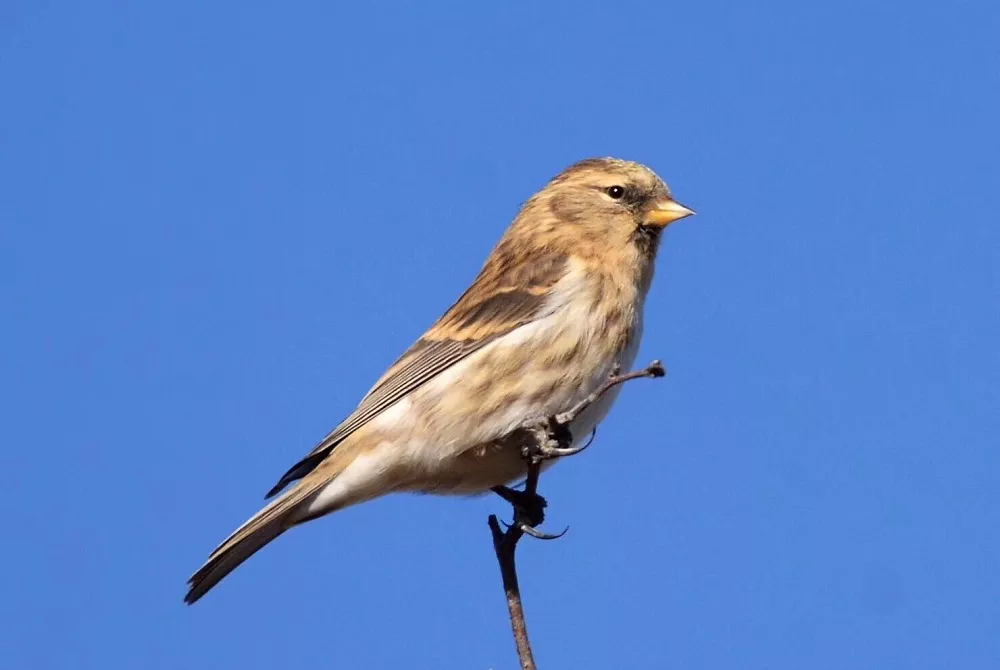The twite bird (Linaria flavirostris) is a small brown passerine bird in the finch family Fringillidae. It is similar in size and shape to a linnet, at 13 to 13.5 cm (5.1 to 5.3 in) long. It lacks the red head patch and breast shown by the linnet and the redpolls. It is brown streaked with black above, and a pink rump. The underparts are buff to whitish, streaked with brown. The conical bill is yellow in winter and gray in summer. The call is a distinctive twit, from which its name derives, and the song contains fast trills and twitters.
What does Twite bird look like
The twite bird male’s forehead, head, pillow, back neck, back and shoulders are generally sandy brown and tan, with thick dark brown feathers, the waist is light rose red, and the tail coverts are dark brown and broad. white plume. The tail is dark brown with white feathers, the outer white feathers are narrower, and the inner white feathers are wider. The wing coverts are brown, the feather margins are sandy brown or tan, and the appearance color is similar to that of the back when folded. The large coverts are brown, the feather edges are sandy brown, and the tips are brownish yellow or white. The primary flight feathers are black, the outer feathers are white, the secondary flight feathers are dark brown, the feathers are sandy brown, and the feathers are white. The chin, throat and upper chest are sandy brown or sandy brown, with dark brown longitudinal stripes, the rest of the lower body is light grayish white or white, with dark brown longitudinal stripes, and the vertical stripes from the lower abdomen to the undertail coverts are not obvious.
The female bird is similar to the male bird, but there is no red under the waist, it is pale yellow with light brown longitudinal stripes and white feather margins.
Iris dark brown, mouth pale, yellow in winter and gray in summer, tarsus tarsus dark brown or black.
Twite bird habitat
The twite birds are high-altitude birds, and some subspecies live above 2,500 meters; even as high as 5,000 meters above the snow line. Observed in Shiquanhe, Zhada and Pulan, Tibet, China, inhabits valley bushes, mountain slopes and grasslands at an altitude of 4300-4700 meters; but in winter, it descends to the bushes and thorns at the foot of the mountain or beside the valley stream ground and other low altitudes. It usually lives in open areas, rock walls and crevices with thin grass, or farmland and pastures with gravel, and sometimes in suburbs; but it is not found in forests.
Twite bird living habit
Sex likes to live in groups, generally consisting of 20-30 animals, and some large groups can reach more than 50 animals; the activity time in family groups is longer, up to 2-4 months. The family group likes to rest in the trees, and hides in the dense canopy in bad weather; the adult birds like to move in the bushes and weeds. Herbivorous, the food is mainly grass seeds, pistils and other plant seeds, and a small amount is Coleoptera insects.
Mode of reproduction
The breeding season is between June and July, and some extend to August. Nest in groups on thorns or dwarf willows. The nest is generally not high from the ground, and is relatively solid and cup-shaped. It is made of grass hay, fine roots and weed stems mixed with broken hairs. The inner pad is animal hair and plant down, or bird feathers. The average nest size is 8.5-10.8 cm in outer diameter, 4.5-5.0 cm in inner diameter, 5.0-6.5 cm in height, and 2.5-3.0 cm in depth. Each clutch lays 4-5 eggs, occasionally 7 or 6 eggs. There are two kinds of spots on the eggs: one is composed of reddish-brown spots and irregular small pieces, and the other is light pink-gray spots scattered all over the egg, with chestnut red spots on the blunt end. Chicks are late mature.
Distribution area of the Twite birds
Distributed in Europe and Central Asia, Qinghai-Tibet Plateau, western and central Himalayas to central China.


 Facebook
Facebook  Instagram
Instagram  Youtube
Youtube 